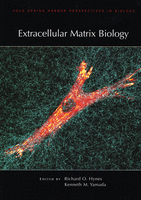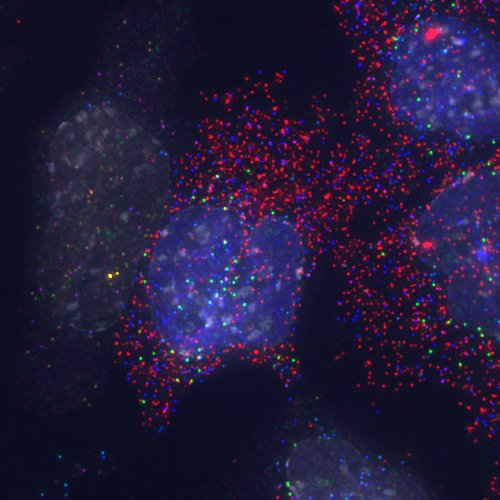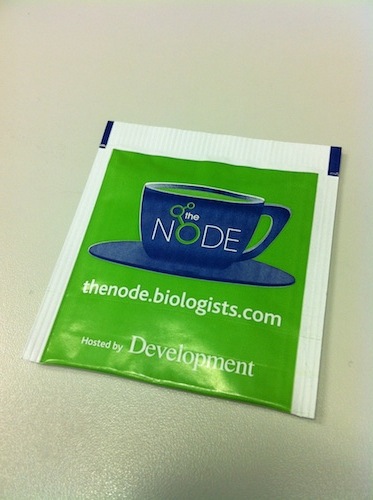This book review originally appeared in Development. Charles Streuli reviews “Extracellular Matrix Biology ” (Edited by Richard O. Hynes and Kenneth M. Yamada).
Book info:
Extracellular Matrix Biology. Edited by Richard O. Hynes, Kenneth M. Yamada Cold Spring Harbor Laboratory Press (2012) 387 pages ISBN 978-1-936113-38-5 $67.50 (hardcover)
 To be metazoan is to have an extracellular matrix (ECM). ECM components evolved simultaneously with animals and provided the architectural scaffold onto which multicellularity could emerge several hundred million years ago. From a primitive basement membrane toolkit and the primordial fibrillin and thrombospondin genes that allowed the evolution of multilayered animals, successive gene duplications and crises permitted the appearance of protostomes and deuterostomes, leading to vertebrates and eventually to us. Along the way, the evolutionary shuffling of pre-existing and novel protein domains to form tenascins, fibronectin and other matrix proteins coincided with the emergence of neural crest, vasculature and the nervous systems that characterise chordates and advanced vertebrates. Coinciding with this, metazoans evolved complex plasma membrane machines containing adhesome proteins that link the ECM to the cytoskeleton and intracellular signalling pathways.
To be metazoan is to have an extracellular matrix (ECM). ECM components evolved simultaneously with animals and provided the architectural scaffold onto which multicellularity could emerge several hundred million years ago. From a primitive basement membrane toolkit and the primordial fibrillin and thrombospondin genes that allowed the evolution of multilayered animals, successive gene duplications and crises permitted the appearance of protostomes and deuterostomes, leading to vertebrates and eventually to us. Along the way, the evolutionary shuffling of pre-existing and novel protein domains to form tenascins, fibronectin and other matrix proteins coincided with the emergence of neural crest, vasculature and the nervous systems that characterise chordates and advanced vertebrates. Coinciding with this, metazoans evolved complex plasma membrane machines containing adhesome proteins that link the ECM to the cytoskeleton and intracellular signalling pathways.
Core ECM proteins make up ∼1.5% of the mammalian proteome. This enormous parts-list of around 300 matrix proteins, newly christened the ‘matrisome’, highlights the diverse and extraordinary roles of the matrix in metazoan biology. ECMs range from pericellular matrices, such as basement membranes, to the grander structures of connective tissue that give organs their shape, and the tendons, cartilage and bones that bestow humans and animals with their form. It is therefore not surprising that the ECM pervades every aspect of metazoan life. The matrix is essential for early embryonic development and it regulates nearly every facet of cell behaviour. Moreover, altered ECM and ECM-cell interactions lie at the root of many diseases, including cancer, diabetes, inflammatory disorders and osteoarthritis.
The ancient history of the association between the ECM and cells effectively means that the two are inseparable. Although the prosaic view of cells is that they end at the plasma membrane, the cell and its pericellular matrix are actually a continuum in all complex animals. A cell’s ECM coat provides the architectural hardware for cell positioning and migration, which is meshed together with intracellular cytoskeletal networks by myriad components of the adhesome. The matrix enables a first-pass checkpoint for growth and developmental signals, it is the vehicle for morphogenetic gradients in development, and it is the spatial rheostat for intracellular signalling pathways. ECM receptors thus convert both chemical and physical extracellular inputs to determine cell survival, proliferation, migration and tissue-specific gene expression.
A book on such a profoundly important topic requires a clear vision of the breadth of the ECM and its roles in development, cell and tissue function and disease. Extracellular Matrix Biology has been organised by two of the most eminent scientists in the ECM research field, Richard Hynes and Kenneth Yamada, and, predictably, the book hits the mark. This volume, one in a series from Cold Spring Harbor Laboratory Press, contains a superb collection of review articles. Well-known opinion-makers in the field have written the chapters, which are detailed, authoritative and up to date. The organisation of the book is sensible, beginning with an overview of the matrisome and its evolution, and then working through the key ECM components, basement membranes, collagens, proteoglycans, tenascins, thrombospondins and fibronectin. This is followed by chapters on integrin activation, genetics, and links with TGFβ, as well as adhesion complexes, mechanotransduction, and matrix remodelling. Towards the end, links between ECM and tissues are considered, with chapters on cell migration, embryonic development, angiogenesis, skin, and the nervous and haemostatic systems. I am slightly disappointed that mucins have been omitted, as they are crucial components of the pericellular matrix, but nevertheless the coverage in the book is excellent overall.
Looking through my (rather dusty) volume of Betty Hay’s Cell Biology of Extracellular Matrix (2nd edition, 1991), which was one of the last comprehensive books on ECM, it is startling to see how many advances have been made since then. Prior to our era of genomics, knockouts and dynamic imaging, much of the knowledge about ECM was based on biochemistry and cytology. Disease associations with altered ECM were known, but many of the molecules involved had not been identified and mechanisms were largely unexplored. Little was understood about the structures of matrix molecules or their receptors, and there was only an indication that integrins could transmit signals from the ECM to the cell interior. It is also interesting that the focus of illustrations has largely switched from electron microscopy images and some relatively sketchy diagrams to detailed lists of ECM components, domain organisations, interaction networks, disease associations, and mouse and human mutations. This new book is therefore a timely addition, and many of the chapters also consider where the field is going now and what unknowns might be unravelled in the cell-matrix field over the next 20 years. Overwhelmingly, the shift in focus from the organisation of the ECM in tissues, to cataloguing its vast array of constituents and interactions with cells, indicates that a central challenge is to understand how all the matrix and adhesion components fit together and how they control cell fate and function.
Although crystal ball gazing is inevitably difficult, there are certainly some exciting opportunities that are alluded to in the book. The emerging awareness that biology occurs in four dimensions and is completely dependent on the ECM (incidentally, this was well understood by Hay) will undoubtedly be a major focus for cell-matrix research at least for the next few years. For example, knowledge of how matrices are assembled in 3D and remodelled in 4D is beginning to appear. Most cells function within communities, often of different cell types, and we are just beginning to understand how the matrix influences cell function and dynamics in 4D and how different cell types use the ECM to communicate, e.g. via stromal-epithelial interactions. The notion that the physics of the ECM profoundly influences cell and tissue function is fuelling new research on how forces are built into ECMs, how they are sensed by cells, and how they are converted to chemical signals that control transcription and cell fate. The structures of ECM proteins and some adhesion signalling proteins have been solved (some only at low resolution), leading to a new focus on atomic interactions at the protein-protein interface. ECM and adhesion receptors are crucial regulators of the immune system, and the dawn of immunomatrix biology is changing the thinking about immunological control. And, most profoundly, the basic discoveries of cell-matrix research are yielding novel small-molecule, bioengineered and genetic therapies for the vast array of diseases caused by altered ECM and interactions between the cell and the matrix. For example, there are no effective cures for osteoarthritis beyond surgery; advances in this (and other) areas using genetic analysis based on genome-wide association studies and systems biology are needed to dissect all of the component parts that cause debilitating diseases of injury and old age, and thereby to develop new treatments.
One of the challenges posed by reviewing this book was to ask who it is for. The original chapters appeared over several months in the online publication Cold Spring Harbor Perspectives in Biology, and they have now been collated for the book. Although some of the articles are available online (depending on your library’s subscription), by combining them in a single volume the editors have created a very nice resource that will provide a valuable reference work for several years to come. I would recommend those entering the field of cell-matrix biology, as well as those already in it, to read the book from cover to cover. The ECM is now understood as being so much more than a tissue scaffold and a precursor for building bones, and this new book definitively indicates where the field is now and where it is going. The intimate connections between the ECM and most cellular processes in animal development are gradually being recognised by mainstream biologists, and this could be accelerated when the key advances in this book are used to update current undergraduate texts on cell biology. At a broader level, once some of these concepts are incorporated within school biology education, then we’ll know that ECM biology has truly come of age.
 (2 votes)
(2 votes)
 Loading...
Loading...


 (2 votes)
(2 votes) (No Ratings Yet)
(No Ratings Yet)

 To be metazoan is to have an extracellular matrix (ECM). ECM components evolved simultaneously with animals and provided the architectural scaffold onto which multicellularity could emerge several hundred million years ago. From a primitive basement membrane toolkit and the primordial fibrillin and thrombospondin genes that allowed the evolution of multilayered animals, successive gene duplications and crises permitted the appearance of protostomes and deuterostomes, leading to vertebrates and eventually to us. Along the way, the evolutionary shuffling of pre-existing and novel protein domains to form tenascins, fibronectin and other matrix proteins coincided with the emergence of neural crest, vasculature and the nervous systems that characterise chordates and advanced vertebrates. Coinciding with this, metazoans evolved complex plasma membrane machines containing adhesome proteins that link the ECM to the cytoskeleton and intracellular signalling pathways.
To be metazoan is to have an extracellular matrix (ECM). ECM components evolved simultaneously with animals and provided the architectural scaffold onto which multicellularity could emerge several hundred million years ago. From a primitive basement membrane toolkit and the primordial fibrillin and thrombospondin genes that allowed the evolution of multilayered animals, successive gene duplications and crises permitted the appearance of protostomes and deuterostomes, leading to vertebrates and eventually to us. Along the way, the evolutionary shuffling of pre-existing and novel protein domains to form tenascins, fibronectin and other matrix proteins coincided with the emergence of neural crest, vasculature and the nervous systems that characterise chordates and advanced vertebrates. Coinciding with this, metazoans evolved complex plasma membrane machines containing adhesome proteins that link the ECM to the cytoskeleton and intracellular signalling pathways.